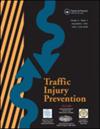Rear passenger restraint in frontal NCAP tests compared to the right-front passenger
IF 1.6
3区 工程技术
Q3 PUBLIC, ENVIRONMENTAL & OCCUPATIONAL HEALTH
引用次数: 0
Abstract
Objective
This study compared kinematic and biomechanic responses of the 5th female Hybrid III in the right-rear and right-front passenger seats in frontal NCAP tests with 2015–16 MY vehicles. It focused on the lap-shoulder belt restraint of the rear passenger.
Methods
Eleven frontal NCAP tests were conducted by NHTSA at 56 km/h with a lap-shoulder belted 5th Hybrid III dummy in the right-rear and right-front seats. The right-front passenger had pretensioning and load limiting belts and advanced airbags with inflatable knee bolster. The rear passenger had seatbelts without pretensioning or load limiting. The kinematic and biomechanical responses of the 5th Hybrid III dummy in the rear and front were analyzed. The tests included onboard video cameras covering the rear and front passenger. Lap and shoulder belt loads were measured. The responses were compared for the two seating positions and restraint systems.
Results
Only one of 11 vehicles had favorable restraint of the right-rear passenger. All vehicles passed criteria for the right-front passenger. The right-rear passenger HIC15 was 888 ± 314 (779 IARV) significantly higher than 242 ± 72 in the right-front passenger (t = 6.36, p < 0.001). The right rear Nij was 1.16 ± 0.19 (1.00 IARV) significantly higher than 0.46 ± 0.11 in the right-front (t = 9.18, p < 0.001) and the rear chest deflection was 46.1 ± 9.8 mm (42 mm IARV) significantly higher than 20.8 ± 5.6 mm in the right-front (t = 7.12, p < 0.001). The shoulder belt load was 8,771 ± 2,088 N on the right-rear passenger significantly higher than 3,564 ± 911 N on the right-front (t = 7.28, p < 0.001). Three of the 11 crash tests involved submarining by the right-rear passenger at 76.0 ± 7.2 ms. Two tests with submarining involved the seatbelt buckle lifting by shoulder belt load pulling the lap belt onto the abdomen. One test involved compressing the front of the seat cushion with the H-point dropping, the pelvis rotating rearward and the lap belt sliding onto the abdomen.
Conclusions
Restraining loads on the rear passenger were significantly higher than on the right-front passenger in 2015–16 MY vehicle NCAP tests. The HIC15 was 3.7-times higher in the rear passenger than the front. The Nij was 2.5-times higher and chest deflection was 2.2-times higher. The dummy responses were significantly higher in the rear seat compared to the front seat because of greater restraining loads, submarining and a hardware failure in NCAP tests. The lack of pretensioning, load limiting and airbags involved higher injury risks in the rear passenger compared to the right-front passenger.
与右前乘客相比,后排乘客在正面 NCAP 测试中受到的约束。
目标:本研究比较了 2015-16 MY 车辆在正面 NCAP 测试中右后方和右前方乘客座位上第 5 位女性混合动力 III 的运动学和生物力学反应。研究重点是后排乘客的膝肩带约束:美国国家公路交通安全管理局以 56 km/h 的速度进行了 11 次正面 NCAP 测试,在右后座和右前座上分别安装了第 5 代混合动力 III 型假人。右前乘客配有预紧和负载限制安全带,以及带膝部充气垫的高级安全气囊。后排乘客的安全带没有预紧或负载限制功能。对后排和前排第 5 个混合动力 III 型假人的运动学和生物力学反应进行了分析。测试包括覆盖后排和前排乘客的车载摄像机。测量了腰带和肩带的负荷。对两个座位位置和约束系统的反应进行了比较:结果:11 辆车中只有一辆车对右后排乘客的约束良好。所有车辆的右前乘客均符合标准。右后座乘客的 HIC15 为 888 ± 314(779 IARV),明显高于右前座乘客的 242 ± 72(t = 6.36,p t = 9.18,p t = 7.12,p t = 7.28,p 结论:在 2015-16 MY 车辆 NCAP 测试中,后排乘客的约束载荷明显高于右前乘客。后排乘客的 HIC15 是前排乘客的 3.7 倍。Nij高出2.5倍,胸部变形高出2.2倍。与前排座椅相比,后排座椅的假人反应明显更高,这是因为在 NCAP 测试中出现了更大的约束载荷、潜入和硬件故障。与右前乘客相比,后排乘客由于没有预紧装置、负荷限制装置和安全气囊,受伤风险更高。
本文章由计算机程序翻译,如有差异,请以英文原文为准。
求助全文
约1分钟内获得全文
求助全文
来源期刊

Traffic Injury Prevention
PUBLIC, ENVIRONMENTAL & OCCUPATIONAL HEALTH-
CiteScore
3.60
自引率
10.00%
发文量
137
审稿时长
3 months
期刊介绍:
The purpose of Traffic Injury Prevention is to bridge the disciplines of medicine, engineering, public health and traffic safety in order to foster the science of traffic injury prevention. The archival journal focuses on research, interventions and evaluations within the areas of traffic safety, crash causation, injury prevention and treatment.
General topics within the journal''s scope are driver behavior, road infrastructure, emerging crash avoidance technologies, crash and injury epidemiology, alcohol and drugs, impact injury biomechanics, vehicle crashworthiness, occupant restraints, pedestrian safety, evaluation of interventions, economic consequences and emergency and clinical care with specific application to traffic injury prevention. The journal includes full length papers, review articles, case studies, brief technical notes and commentaries.
 求助内容:
求助内容: 应助结果提醒方式:
应助结果提醒方式:


